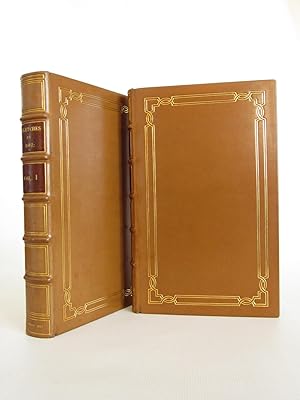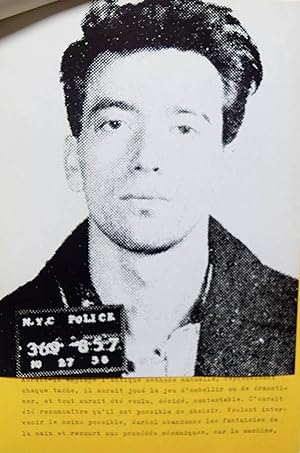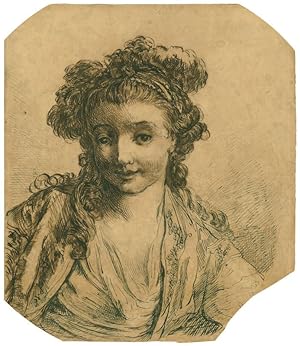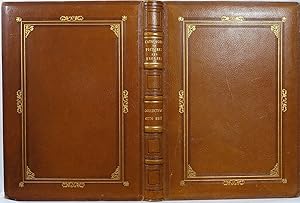rembrandt (Más de 49.000 resultados)
Tipo de artículo
- Todo tipo de artículos
- Libros (46.740)
- Revistas y publicaciones (283)
- Cómics (21)
- Partituras (13)
- Arte, grabados y pósters (996)
- Fotografías (231)
- Mapas (6)
-
Manuscritos y
coleccionismo de papel (1.335)
Condición
Encuadernación
Más atributos
- Primera edición (4.577)
- Firmado (590)
- Sobrecubierta (5.720)
- Con imágenes del vendedor (21.042)
- Sin impresión bajo demanda (46.859)
Gastos de envío gratis
Ubicación del vendedor
Valoración de los vendedores
-
A Bibliography of William Blake.
Publicado por New York: Grolier Club, . First Edition. One of 250 printed at The Chiswick Press., 1921
Librería: Lighthouse Books, ABAA, Dade City, FL, Estados Unidos de America
Ejemplar firmado
Signed. Thick quarto, original quarter navy blue morocco & blue cloth (hardcover, leather), top edge gilt, 516 pp. Forty-four plates (four in color) and twelve illustrations. Very Good. This copy is the Dedication Copy, bearing an inscription on the front free endpaper from Keynes to the book's dedicatee, William Bateson: "W. Bateson from Geoffrey Keynes, February 1922." Also a printed slip tipped inside the front cover designates this copy as being assigned by The Grolier Club to the author for presentation to Bateson. An ALS from W. A. Raleigh, English essayist and biographer, written from Oxford, dated 19-v-06 and addressed to William Bateson is laid-in. In it Raleigh comments on Blake's works and beliefs: "His [Blake's] heresy on 'nature' is everywhere. I am sure he held it passionately and sincerely. and I think it more respectful to Blake to say so than to 'make allowances' for him. Shakespeare, Cervantes, Rembrandt &t. had sympathy with men as they are. Milton, Blake, &c. had not. Where's the harm? So I don't mean to give up all claim to Blake. The sects, and the aesthetes, and the hobby-mongers have been a plague of flies around him. But they must not be allowed to have him all to themselves." William Bateson (1861-1926) was a leading botanist and biologist whose research in the field of evolution focused on the discontinuity of variations in the process of heredity. "More than any other man Bateson was the founder of the experimental study of heredity and variation which was now providing a fresh orientation to the biological sciences -- a study for which he invented the term 'genetics." -- Dictionary of National Biography. In addition to his work in the field of biology, Bateson was an ardent and informed collector of art, especially Japanese woodblock prints, drawings of the old masters, and the etchings of William Blake. "The same keen sense of form which infused Bateson's science and writing found another outlet in his appreciation of art." -- DNB. Geoffrey Keyes, brother of the economist and the author of this work, is better known for his medical work where he made notable innovations in the fields of blood transfusion and breast cancer surgery. Throughout his life, however, Keynes maintained an active interest in English literature and published several biographies and bibliographies. Most noted in this field was his passion for the works of William Bake in which he became a leading authority on Blake's literary and artistic work. Literature, Author Biography. KHS - X31.
-
A Selection from the Collection of Drawings by Old Masters formed by C. Fairfax Murray
Librería: Jonathan A. Hill, Bookseller Inc., New York, NY, Estados Unidos de America
292 plates in black & white and sepia. 14 unnumbered leaves. 4to, orig. green half-morocco & green cloth (spine slightly faded & upper hinge slightly rubbed), spine gilt, t.e.g. London: Privately Printed, [1904]. The rare privately printed catalogue of Old Master drawings sold to J. Pierpont Morgan for nearly $4,000,000 in today's money. Murray (1849-1919), involved in all aspects of the art world in the course of his life, began to amass this collection while serving as an agent for the Director of the National Gallery and several private collectors in Italy. He helped cultivate American collectors new on the scene and guided the development of some of the most illustrious collections. After he had sold his collections of rare books and most of his art, this collection of about 1400 drawings remained and proved to be his most significant sale. The 292 plates capture the highlights of the collection by artists such as Botticelli, Del Sarto, Raphael, Caravaggio, Caracci, Breughel, Rembrandt, Rubens, Van Dyck, Poussin, Watteau, Fragonard, Oudry, etc. Fine copy, plates in excellent condition.
-
Muirhead Bone: Marble Arch, 1915 (Original pencil drawing, signed, inscribed and dated 'Aug 18 1915 Marble Arch' 187 x 287 mm)
Librería: Lott Rare Books, Banstead, SRY, Reino Unido
Ejemplar firmado
Condición: Fine. Exceptional Pencil Drawing. Muirhead Bone (1876 -1953): MARBLE ARCH, 1915. Original pencil drawing, signed, inscribed and dated 'Aug 18 1915 Marble Arch' 187 x 287 mm. A fascinating visual record of life on a specific day in London during The Great War. Marble Arch is on the immediate left, whilst the artist observes both the demolition of the imposing building at the heart of the picture and the daily activity in the street below. This drawing is dated an exact year to the day before Bone painted the picture, 'Battle of the Somme', on 18 August 1916, as the newly appointed first War Artist, which is now in The British Museum. Excellent condition. (Framed). Provenance: Garton & Co, 1989. Exhibited: Crawford Centre For The Arts, University Of St. Andrews, 1986; Glasgow Art Gallery, 1987. SIR MUIRHEAD BONE 1876 -1953: Muirhead Bone was born in Partick, a suburb of Glasgow in 1876. As a young man he was apprenticed to a firm of architects and in the evenings attended classes at the Glasgow School of Art. Aware his vocation was art, and not architecture, he devoted his time almost exclusively to drawing. He continually sketched the streets, buildings and slums of Glasgow imbuing the urban decay with a dignity and sentiment he so admired in the work of the Dutch artists whose townscapes he had studied in the Glasgow Corporation Art Galleries. Bone moved to London in 1901, holding his first exhibition at the Carfax Gallery in 1902. His success both critically and financially was rapid. His status as an etcher in the early years of the last century placed him amongst the worlds most celebrated artists. It is not an exaggeration to say that his international reputation among collectors and the curators of the 'Great Print Rooms' of Europe and America was without parallel. He was appointed the first Official War Artist in World War I and was the doyen of War Artists in the Second World War. He was instrumental in the foundation of The Imperial War Museum, and became a Trustee of The Tate and The National Gallery. He was knighted for his services to art in 1937. Taste, fashion and the culture of the period have inevitably changed, but the essence of his inspiration and the 'curious hard beauty' of his work remains. 'Few drawings have been seen to equal his, since the time of Rembrandt, and in his studies of scaffold-covered buildings in the breaking or the making, he has followed an individual path and shown a feeling for the great harmonies of line which is beyond praise', Arthur M. Hind, Keeper of the Department of Prints, British Museum, 1933-1945. Signed by the artist.
-
A Corpus of Rembrandt Paintings VI (Hardcover)
Publicado por Springer, Dordrecht, 2014
ISBN 10: 9401792542ISBN 13: 9789401792547
Librería: CitiRetail, Stevenage, Reino Unido
Libro
Hardcover. Condición: new. Hardcover. A revised survey of Rembrandts complete painted oeuvre.The question of which 17th-century paintings in Rembrandts style were actually painted by Rembrandt himself had already become an issue during his lifetime. It is an issue that is still hotly disputed among art historians today.The problem arose because Rembrandt had numerous pupils who learned the art of painting by imitating their master or by assisting him with his work as a portrait painter. He also left pieces unfinished, to be completed by others. The question is how to determine which works were from Rembrandts own hand. Can we, for example, define the criteria of quality that would allow us to distinguish the masters work from that of his followers? Do we yet have methods of investigation that would deliver objective evidence of authenticity? To what extent do research techniques used in the physical sciences help? Or are we, after all, still dependent on the subjective, expert eye of the connoisseur? The book provides answers to these questions. Prof. Ernst van de Wetering, the author of our forthcoming book which deals with these questions, has been closely involved in all aspects of this research since 1968, the year the renowned Rembrandt Research Project (RRP) was founded. In particular, he played an important role in developing new criteria for authentication. Van de Wetering was also witness to the way the often overly zealous tendency to doubt the authenticity of Rembrandts paintings got out of hand. In this book he re-attributes to the master a substantial number of unjustly rejected Rembrandts. He also was closely involved in the (re)discovery of a considerable number of lost or completely unknown works by Rembrandt.The verdicts of earlier specialists including the majority of members of the original RRP (up to 1989) were based on connoisseurship: the self-confidence in ones ability to recognise a specific artists style and hand. Over the years, Van de Wetering has carried out seminal research into 17th-century studio practice and ideas about art current in Rembrandts time. In this book he demonstrates the fallibility of traditional connoisseurship, especially in the case of Rembrandt, who was par excellence a searching artist.The methodological implications of this critical view are discussed in an introductory chapter which relates the history of the developments in this turbulent field of research. Van de Weterings account of his own involvement in it makes this book a lively and sometimes unexpectedly personal account.The catalogue section presents a chronologically ordered survey of Rembrandts entire painted oeuvre of 336 paintings, richly illustrated and annotated. For all the paintings re-attributed in this book, extensive commentaries have been included that provide a multi-facetted new insight into Rembrandts world and the world of art-historical research. Rembrandts Paintings Revisited is the concluding sixth volume of A Corpus of Rembrandt Paintings (Volumes I-V; 1982, 1986, 1989, 2005, 2010). It can also be read as a revisionary critique of the first three Volumes published by the old RRP team up till 1989 and of Gersons influential survey of Rembrandts painted oeuvre of 1968/69. At the same time, the book is designed as an independent overview that can be used on the basis that anyone seeking more detailed information will be referred to the five previous (digital versions of the) Volumes and the detailed catalogues published in the meantime by the various museums with collections of Rembrandt paintings. This work of art history and art research should belong in the library of every serious art historical institute, university or museum. A revised survey of Re Shipping may be from our UK warehouse or from our Australian or US warehouses, depending on stock availability.
-
L'APPRENTIE. Préface de Henry Céard. Eaux-fortes et pointes sèches dessinées et gravées par Auguste Brouet.
Año de publicación: 1924
Librería: LIBRAIRIE ÉRIC CASTÉRAN, TOULOUSE, MP, Francia
Miembro de asociación: ILAB
Original o primera edición Ejemplar firmado
BROUET (Auguste). Ilustrador. Paris, Frédéric Grégoire, 1924. Grand in-quarto (226 X 284) maroquin cerise, dos quatre nerfs, auteur et titre dorés, coupes et coiffes ornées, doublure de soie moirée lie-de-vin bordée d'un cadre de même maroquin décoré d'un filet doré, gardes de soie moirée grenat, contregardes de papier marbré or et argent, tête dorée, plats et dos de la couverture conservés, étui bordé (TRINCKVEL) ; (2) ff. blancs, (1) f. contenant un dessin original, faux-titre, portrait frontispice, titre en rouge et noir orné d'une vignette, VIII-185 pages, (1) f. d'achevé d'imprimer. BELLE ÉDITION ILLUSTRÉE de ce texte dont l'édition originale a paru en 1908. Elle contient un PORTRAIT de l'auteur en couverture, repris en frontispice, une vignette de titre, 12 PLANCHES hors-texte en deux états, et 12 têtes de chapitre et culs-de-lampe d'Auguste BROUET. Tirage limité à 162 EXEMPLAIRES, celui-ci un des 110 numérotés sur vélin blanc d'Arches (n°74). Exemplaire enrichi d'un MAGNIFIQUE DESSIN ORIGINAL à l'encre noire et à l'aquarelle, à pleine page, signé par Auguste Brouet. Un petit MOT AUTOGRAPHE signé par l'auteur, daté du « 4 mars 1919 » et adressé à l'éditeur Van Bever, a été contrecollé sur le second feuillet blanc. Auguste BROUET (1872-1841) est un graveur peu connu du grand public mais très recherché par les amateurs, et dont Gustave Geffroy disait qu'il était «illustre dans la pénombre», expression qui mettait l'accent, en outre, sur ce clair obscur qu'il pratiquait selon la leçon de Rembrandt. BEL EXEMPLAIRE en maroquin janséniste de TRINCKVEL. (Monod, 5233 - Benezit,T. II, p. 333 - Mahé,"Bibliographie des livres de luxe", T. II, p. 190). FINE COPY. PICTURES AND MORE DETAILS ON REQUEST.
-
A Descriptive Catalogue of Rare Engravings in First States and Proofs forming the Collection at 40, Grosvenor Square of.
Librería: Jonathan A. Hill, Bookseller Inc., New York, NY, Estados Unidos de America
1 p.l., 110 pp. 4to, attractive modern green cloth, upper cover gilt, spine gilt, t.e.g. London: [Chiswick Press], 1898. Second edition, enlarged with recent acquisitions; limited to 75 copies. An earlier, smaller, edition appeared in 1884. Tennant (1823-1906), was a Scottish industrialist who greatly expanded the chemicals company started by his grandfather.He was one of the earliest provincial industrialists to become a major metropolitan figure, and held magnificent parties at his great house in Grosvenor Square."-ODNB. This catalogue enumerates Tennant's exceptional collection of hundreds of engravings by artists such as Rembrandt, Joshua Reynolds, and J.M.W. Turner. There is an index of artists at the end. Nice copy printed on fine paper. Inscribed by Tennant: "To Lord Ribblesdale from Charles Tennant, 1st May 1898." The 4th Baron Ribblesdale (1854-1925), was Tennant's son-in-law, who married his second daughter Charlotte in 1877. WorldCat locates only three copies in North America.
-
Catalogue d'une belle Collection de Tableaux, et Bustes en marbre. Dont la majeure partie provient du célèbre Cabinet de.vendue le 22, & jours suivans. Par F.C. Joullain fils
Librería: Jonathan A. Hill, Bookseller Inc., New York, NY, Estados Unidos de America
36 pp. 8vo, late 19th-century green morocco-backed marbled boards (extremities a little worn), title on spine. Paris: Joullain, 1775. A rare sale catalogue describing an impressive group of paintings. Lassay (1652-1738), known as the "Don Juan du Grand Siècle" due to his dissipated personal life, was a man of letters and supporter of the libertines. His son, Léon de Madaillan, the comte de Lassay (1683-1750), commissioned the construction of the Hôtel de Lassay, now the residence of the president of the Assemblée nationale. Charlotte Guichard has written that unscrupulous experts continued to employ the Lassay family name to promote sales decades after their deaths, even when little to nothing in the sale had actually belonged to them. This catalogue details 84 lots, all but one are paintings. The paintings include the work of Parmigianino, Albani, Caravaggio, Castiglione, A. Locatelli, J. Brueghel, Bril, Teniers, Jordaens, Rembrandt, F. Bol, Asselijn, Huysum, Callot, N. Poussin, Claude Le Lorrain, Le Nain, E. Le Sueur, Bourdon, B. Boullogne, J. Parrocel, Le Moine, Lancret, etc. Nice wide-margined copy. Foxing to final few leaves. As usual, not bound with the supplement of 12 pages. Engraved bookplate of [H]enry [Pannier] (1853-1935), the Parisian art dealer, and stamp of the Bibliothèque Heim on verso of title. â § Lugt 2413. Guichard, Les Amateurs d'Art à Paris au XVIIIe siècle (2008), p. 109.
-
Catalogue des Tableaux précieux des Ecoles d'Italie, de Hollande, de Flandres et de France; Dessins, Bronzes, Porcelaines, Pendules, Candelabres, et autres objets de grande Curiosité, composant le Fonds de Commerce du.dont la Vente se fera.le 4 Ventôse, An 6, (Jeudi 22 Févier [sic] 1798).[Expert: A.J. Paillet]
Librería: Jonathan A. Hill, Bookseller Inc., New York, NY, Estados Unidos de America
38 pp. 8vo (195 x 128 mm.), late 19th-cent. brown morocco-backed marbled boards, spine gilt. Paris: Paillet, Boileau & La Fontaine, An VI [1798]. The scarce auction catalogue of a collection of paintings assembled by the artist and dealer Lafontaine (1758-1835). In a recent study, Carole Blumenfeld writes: "As early as 1796, Lafontaine organized two initial sales without catalog at the Hôtel de Bullion.during the course of 1798, he effected a clear change in his commercial strategy, appreciably reducing the proportion of French artists between his two sales, in January and December, and investing the profits from the first sale in Holland over the ensuing months."-p. 220. Although she does not mention the present sale, her assertion that Lafontaine intended to liquidate much of his stock matches the explanation given by the author of the Avant-Propos, likely Paillet. He states (in trans.): "Everyone knows that around ten years ago he left an Art in which he held a rather distinguished rank, in order to deliver himself to the speculation of Commerce. He has determined today to abandon Commerce to return to the gentler occupation of his Easel; and it is in view of this that he entrusted us to sell it.the product of which in advance he used in the acquisition of real estate." This catalogue describes 247 lots of paintings, drawings, sculptures, chandeliers, etc. The paintings include works by da Vinci, F. Mola, Canaletto, Rubens, Rembrandt, Bol, Dou, D. Teniers, Dujardin, Wouwerman, Weenix, I. van Ostade, C. Netscher, S. Bourdon, Natoire, J. Vernet, H. Robert, Greuze, J. H. Fragonard, etc. The paintings are concisely detailed and measurements are provided. Nice copy of this rare sale catalogue; WorldCat and the Getty Provenance Index locate only one example in North America. Engraved bookplate of G[eorges] P[annier] (1853-1944), the Parisian art dealer and collector of auction catalogues, and stamp of the Bibliothèque Heim on verso of title. â § Lugt 5713. J. Edwards, Alexandre Joseph Paillet: Expert et marchand de tableaux à la fin du XVIIIe siècle (1996), pp. 289-90. C. Blumenfeld, "Pierre-Joseph Lafontaine and His Exploitation of European Art Market Imbalances in Paris and London, 1795-1815" (pp. 217-30), in S. Avery-Quash & C. Huemer, eds., London and the Emergence of a European Art Market, 1780-1820 (2019), p. 218-"Lafontaine in fact played an important role in the development of the European art market during this period beset by major upheavals. For the years 1795-1815 alone, the Getty Provenance Index records 1,690 transactions under his name in Germany, France, Belgium, Holland, and Great Britain, and demonstrates that he was drawing far superior profits from the market than his Parisian colleagues. Most importantly, he was the only Fleming equally at ease in Paris and London and the only dealer whose business survived the political vicissitudes, enabling him to continue working from the 1780s to the July Monarchy." See this chapter for a wonderful in-depth examination of Lafontaine's evolution from artist to titan of the European art trade.
-
Catalogue des Tableaux, Estampes en livres & en feuilles, Cartes manuscrites & gravées, montées à gorges & rouleaux; Du Cabinet de feû. Dont la Vente se fera le Lundi 21 Juin & jours suivans. Par les Ssrs Pierre Remy & Benoît Audran
Librería: Jonathan A. Hill, Bookseller Inc., New York, NY, Estados Unidos de America
Ejemplar firmado
15, [1] p. 8vo (189 x 125 mm.), 19th-cent. red cloth (signed "Pierson"), title on spine. Paris: Lottin & Musier, 1762. A rare and early art auction catalogue, fully priced in a contemporary hand, and bound by Pierson in the red percaline preferred by the Goncourt brothers. Chauvelin, marquis de Grosbois (1685-1762) and Louis XV's secretary of foreign affairs, was exiled due to the machinations of his rival Cardinal Fleury in 1737 and spent his final years in Paris. He was one of the earliest clients of Watteau. 81 lots, with paintings attributed to or after Raphael, Giorgione, Guido Reni, Bassan, D. Teniers, Neefs, Rembrandt, Champaigne, Watteau, N. Coypel, etc.; famous print ensembles of the early 18th century; and manuscript and printed maps. Remy and Audran's erudite comments are very interesting to read. A fine, priced copy, very likely from the famous library of the Goncourt brothers. With the engraved bookplate of G[eorges] P[annier] (1853-1944), the Parisian art dealer and collector of early art auction catalogues, on the front paste-down, and stamp of the Bibliothèque Heim on verso of title. â § Lugt 1232. P. Michel, Peinture et Plaisir: Les Goûts picturaux des Collectionneurs Parisiens au XVIIIe siècle, p. 247. See Bibliothèque des Goncourt, XVIIIe siècle (29 March-3 April 1897), lot 207.
-
Catalogue raisonné de la rare et précieuse Collection d'Estampes, et de quelques Tableaux, Bronzes, Porcelaines, et Meubles, du Cabinet de feu. Par F. L. Regnault-Delalande. Cette Vente se fera dans la Maison de feu M. Logette, rue de Richelieu, no. 95.le Mardi 6 Mai, et jours suivans.
Librería: Jonathan A. Hill, Bookseller Inc., New York, NY, Estados Unidos de America
x, 64 pp., 1 leaf of vacations. 8vo (216 x 142 mm.), late 19th-cent. calf-backed marbled boards, blue morocco lettering-piece on spine. Paris: Guyot & Regnault-Delalande, 1817. An important and rare print auction catalogue, fully priced in a contemporary hand; we locate only one copy in North America. The seller may have been François Etienne Logette, who is recorded as living on rue de Richelieu in previous years. A wealthy merchant, he put together an impressive group of prints, which this sale's expert, Regnault-Delalande (1762-1824), has described in much greater detail than his customary catalogue entries. The 191 lots, mostly prints, include works by Audran, Bartolozzi, N. Berghem, C. Bloemaert, Boissieu, An. Carracci, Desnoyers, Dürer, van Dyck, Earlom, Edelinck, Goltzius, Hollar, Ingouf, S. Le Clerc, Mantegna, Massard, Morghen, Nanteuil, Poilly, Potter, Rembrandt, W. Sharp, Strange, Tardieu, C. Visscher, Vivares, Wille, Woollett, etc. There are also paintings by Lantara, along with sculptures and ceramics by Bouchardon. For each print, Regnault-Delalande provides a succinct biography of the artist, the title, measurements, state (many first or avant-lettre), and comments on the item's rarity. He also notes when he has previously sold a lot in one of his auctions. A very detailed sale catalogue of prints, in near fine condition, with contemporary price annotations. Sporadic and inoffensive foxing, and without the printed price-list that is found in some copies. With the amusing engraved bookplate of [H]enry [Pannier] (1853-1935), the Parisian art dealer and collector of early art auction catalogues, on the front paste-down, and stamp of the Bibliothèque Heim on verso of title. â § Lugt 9131. C. Blanc, Le Trésor de la curiosité. (1857-58), Vol. II, pp. 312-16.
-
Geography Bewitched or a droll Caricature Map of England and Wales.
Publicado por Printed for Bowles & Carver, No. 69 St. Paul's Church Yard, [c1795]., London,, 1795
Librería: Daniel Crouch Rare Books Ltd, London, Reino Unido
Mapa
Dighton's caricature map of England and Wales Engraved caricature map with fine original hand-colour, tape marks to margins, tear to imprint skilfully repaired, with minor loss. Robert Dighton (1752-1814) was well known as a portrait artist and is regarded as one of the most talented social caricaturists of the late 18th and early 19th centuries. As an artist, he was first offered consistent employment by the publisher Carington Bowles (fl.1752-1793). This was the heyday of the so-called 'droll' mezzotint and Robert's output of designs, executed in watercolour and then engraved, was an integral part of his stock. Carington Bowles was among of the most active mapsellers of his day in London, which will explain Dighton's caricature maps in his "Geography Bewitched" series, including Ireland, England and Wales (the present map), and Scotland. At the beginning of the nineteenth century, he would achieve notoriety when he was found to have stolen valuable prints from the British Museum, which he sold through his shop in Charing Cross. His crime was exposed when a dealer, but the name of Samuel Woodburn, having acquired a Rembrandt etching from Dighton, went to the British Museum to compare it with their copy, whereupon he found the print to be missing. Dighton later confessed that he had befriended a museum official by drawing portraits of him and his daughter during his visits and used this relationship to remove prints from the museum hidden in his portfolio.
-
CERVANTES.
Publicado por Ed. Rembrandt. Alicante, 1978, 1978
Librería: Libreria Anticuaria Farré, Barcelona, BARCE, España
. 54,5 cm. 19 pliegos de 2 hojas en papel de hilo (edición sin paginar). Impreso a varias tintas y tipografías. Ilustr. a cargo de Gregorio Prieto. En rama, presentado en estuche editorial, en piel, con algunas rozaduras. Tirada de 95 ejemplares, numerados del 1 al 95, conteniendo 17 ilustraciones en serigrafía y realzadas a mano y firmadas por el artista (ej. 34), de una edición única de 125 ejemplares. Bibliofília. Cervantina. Gregorio Prieto.
-
Cominciamento e progresso dell'Arte dell'intagliare in rame, colle vite di molti de' più eccellenti Maestri della stessa Professione. Opera di Filippo Baldinucci Fiorentino, Accademico della Crusca. All'Illustriss. Sig. Abate Francesco Marucelli.
Año de publicación: 1686
Librería: LIBRERIA PAOLO BONGIORNO, Modena, MODEN, Italia
Libro Original o primera edición
Rilegato. Condición: molto buono. prima edizione. In Firenze, Nella Stamperia di Piero Matini all'Ins. del Lion d'Oro, 1686. In 4to grande (cm. 26); legatura coeva in piena pergamena, grande vignetta incisa con l'emblema dell'Accademia della Crusca al frontespizio; pp. (8), VIII, 124. Bellissima copia ad ampi margini. PRIMA edizione di una delle più importanti opere del Baldinucci che gli valse l'ammissione all'Accademia della Crusca con il nome di Lustrato: il grande storico dell'arte Julius Schlosser Magnino lo considerò un venerando antenato della sua professione. Nel 1681 fu a Roma dove Francesco Marucelli lo introdusse alla corte di Cristina di Svezia che gli commissionò la vita di G.L. Bernini, morto l'anno prima e da lei enormemente ammirato. Dopo il Proemio, che traccia una storia generale della disciplina, vi sono, nell'ordine, le vite di A. Durer, Luca di Leida, M.A. Raimondi, Aldegraef, Hubert Goltz, G. Sadalaer, A. Tempesta, R. Sadalaer, Heinrich Goltz, G. Saenredam, E. Sadalaer, J. Callot, C. Bloemaert, S. della Bella, Rembrandt, P. Testa, R. Nanteuil, F. Spierre. Chiude il volume l'Indice delle cose notabili. Cicognara, 248: Opera sempre pregevole, poiché la prima che ci ha parlato delle teorie, e delle memorie di questa classe di artisti, e di opere, oltre al servire per i vocaboli tecnici di testo di Lingua. Axs.
-
Fonte San Gennaro o Ricordo di una passeggiata, 1932
Librería: Il Bulino Antiche Stampe srl, Milano, MI, Italia
Arte / Grabado / Póster
senza rilegatura. Condición: in ottime condizioni. Acquaforte su carta cina applicata misure: mm 252 x 345 Pittore, scrittore, sceneggiatore ed incisore italiano. Dopo gli studi tecnici, compiuti a Jesi, si trasferisce nel 1907 a Siena, dove si iscrive all'Istituto di Belle Arti. Nel 1909 lo troviamo a Roma, dove frequenta l'Accademia di Belle Arti e le lezioni di anatomia, storia dell'arte e letteratura all'Università; all'Accademia di Spagna, a San Pietro in Montorio, segue i corsi di disegno e studia le incisioni di Goya. Fra il 1913 e il 1914 è a Firenze, dove segue lezioni di architettura e anatomia e la scuola di nudo annessa all'Accademia; resta colpito dalle incisioni di Giovanni Fattori e, agli Uffizi, studia le collezioni di antichi disegni e le acqueforti di Rembrandt e Callot. Con Bartolini l'incisione torna ad essere un mezzo di espressione poetica libera dal simbolismo e dal vedutismo allora in voga presso le accademie. L?artista forte della sua indomita libertà espressiva e nonostante il suo essere anticonvenzionale è oggi considerato uno dei più importanti incisori contemporanei del novecento. Nelle sue acqueforti prevale ora un tratteggio leggero (genere biondo), ora una ricerca del chiaroscuro alla Rembrandt (genere nero). Nel 1932 con questa incisione Bartolini ottenne il Primo Premio ex-aequo con Giorgio Morandi e Umberto Boccioni (alla memoria) presso la Mostra per il Bianco e Nero alla Galleria degli Uffizi di Firenze. Il soggetto nasce in studio ma è stato pensato e generato durante lunghe camminate nella natura. La genesi della lastra viene raccontata dall'autore nella prefazione della cartella di dieci acqueforti intitolata: Le carte parlanti, F.lli Buratti, Torino, 1931. Bartolini confessa di aver riunito in questa lastra due figure di lavandaie precedentemente incise in due lastre andate distrutte; confessa anche che la composizione è particolarmente riuscita anche perché ultima di quattro tentativi scartati dallo stesso Bartolini perché insoddisfatto dalla morsura o dal disegno poco spontaneo. Il foglio sembra ospitare momenti e situazioni differenti, quasi degli appunti: in basso a destra un gruppo di quattro persone sono sedute in cerchio a colloquiare, verso il centro altre tre figure sono sedute a terra, mentre sul fondo troviamo due donne di spalle alla fonte intente a lavare i panni. Firma incisa in lastra in basso a sinistra, oltre l'inciso a matita nel margine inferiore: Fonte S. Gennaro, 10/50 e firma. Esposta da Bartolini alla II Quadriennale nazionale d?Arte di Roma del 1935 poi, tra l'altro, nel 1942 a Venezia alla Biennale; nel 1949 a Parigi, nel 1951 a Roma in Calcografia Nazionale. Impressione eccellente stampata su carta cina applicata. Ottimo stato di conservazione. Bibliografia: Gli esemplari unici e rari, n 98; Petrucci n 338.
-
Catalogus van de weergalooze en eenigste volkoome verzameling der printkunst van Rembrandt, met alle haar' veranderingen, door zyn' eige hand in 't koper gebragt. Bestaande in 257 portretten, 161 historiën, 152 figuren, en 85 landschappen: t'samen 655 printen, waaronder 165 stuks die men elders niet aangetroffen heeft. Gezamenlyk van d'oudste-, schoonste- en bestgesteldste drukken. Vergaderd zedert den jaare 1728 tot heden, door den heer Amadé de Burgy. Welke in't openbaar verkogt zal worden ten zynen huize, in 's Hage. Op maandag den 16 juni 1755, door Pieter Gerard van Baalen, kunst- kaart- en boekverkooper. / Catalogue de l'incomparable et la seule complette collection des estampes de Rembrandt, avec toutes leurs variations, gravées par sa propre main. Contenant 257 portraits, 161 histoires, 152 figures, et 85 païsages: faisant ensemble 655 estampes, entre lesquelles sont 165 pièces qu'on n'a pas trouvées ailleurs. Toutes des plus anciennes, belles, & mieux conditionées epreuves. Re
Publicado por The Hague, 1755
Librería: Antiquariaat Berger & De Vries, Groningen, Holanda
Half leather binding with ribs on spine. 8o. (XVI) 85 pp. Both Dutch and French title pages illustrated. Boards rubbed, spine somewhat chipped, from page 39 onward bottom half of pages suffered from water stains.
-
Komste van Zyne Majesteit Willem III. Koning van Groot Britanje, enz. in Holland; ofte omstandelyke beschryving van alles, het welke op des zelfs komste en geduurende zyn verblyf, in 's Graavenhaage en elders, ten teeken van vreugde en eere, is opgerecht en voorgevallen [.].
Publicado por The Hague, Arnoud Leers, 1691., 1691
Librería: Antiquariat INLIBRIS Gilhofer Nfg. GmbH, Vienna, A, Austria
Original o primera edición
Folio (ca. 268 x 395 mm). (10), 127, (1) pp. With engraved title-page, 14 (instead of 15) engraved plates (11 of which double-page sized), and woodcut printer's device to title-page. Contemporary giltstamped full calf with title label to spine. First edition. Lavishly illustrated account of the 1691 entrance of William of Orange, King William III of England and stadtholder of Holland, to The Hague, the place of his birth. The splendid plates by the Dutch artist Romeyn de Hooghe (1645-1713) show the ceremonial architecture erected in William's honour as well as parades, grand fireworks, and the King's route, including his arrival at Honslerdyk castle, his passing Westend bridge with several windmills in the background, and the triumphal arches with their allegorical designs. - Wants the engraved portrait of William by Philipp van Gunst. Binding somewhat rubbed, spine-ends chipped, hinges starting, corners repaired. A few leaves show marginal tears, barely affecting text or image. A good, wide-margined copy of this sumptuous work of monarchical representation. - Lipperheide 2667. Kat der Ornamentstichsammlung Berlin 2952. Ruggieri 1095. Vinet 752. Graesse I, 419. Landwehr, Splendid Ceremonies 146. Landwehr, R. de Hooghe as book illustrator 79. Printmaking in the Age of Rembrandt, cat. Museum of Fine Arts Boston, 209. Lotz, Das Feuerwerk 105. Sievernich, Feuerwerkskunst 6/36.
-
Diccionario muy copioso de la lengua Española y Françesa.
Publicado por Bruxelles, chez Rutger Velpius, 1606
Librería: Sokol Books Ltd. ABA ILAB, London, Reino Unido
Libro
Hardcover. Condición: Good. [AN ANATOMIST S COPY]8vo. 2 parts in 1, 414, 306 unnumbered pp. Roman letter, with Italic, double column. Decorated initials and ornaments. Slight marginal foxing, upper edge dusty, light age browning to a few gatherings, intermittent light water stain to lower blank margin of second part. A good, clean copy in contemporary Dutch vellum, yapp edges, a.e.r., ms. binder s instructions ( E. 8vo.VI.14. F[lorins?] 1 ) to front pastedown, ms. ex-libris Sebastiani Egberti (?) @ 1607 Martij 10 (in red), Joan Spillieurs 1649: 10 feb. Geerfft van and Johannes Carlier 1638 2/25 to ffep. A good, clean copy of the second edition of the first French-Spanish bilingual dictionary, originally published in Paris in 1604. The French Jean Pallet (or Palet, fl. late C16/early C17) was physician to Henry IV of France and translator from the Italian of Discours de la beauté des Dames (1568). An influential lexicographer, he published his bilingual dictionary only a few years after Hornkens s French-Spanish-Latin of 1599. Even more than Hornkens, Pallet was catering to the Belgian aristocracy, generals and officers who, upon the Infanta s marriage with Archduke Albert in 1596 and the greater administrative autonomy over the Low Countries granted to them by her father Philip II, found themselves having to deal with a Spanish-speaking court ( Wörterbücher , 2977). The printer Velpius was granted a privilege by the Archduke. Whilst the French-Spanish part was mostly based on Hornkens, the Spanish-French section drew on Antonio de Nebrija s Spanish-Latin dictionary (1492-5) and Cristóval de Las Casas s popular Tuscan-Castilian dictionary of 1570. In 1607, this copy was in the library of the Flemish physician Sebastianus Egbertus, professor of anatomy at Amsterdam and author of a commentary on Dodoens s Herbal (1640); he was deemed a man of great learning by the anatomist Nicolaes Tulp, famously portrayed by Rembrandt. In 1638, it was in the possession of the lawyer Johannes Carlier (c.1612-48), owner of a substantial library of which the inventory unusually specifies the colour of the shelves and their arrangement in the room (de Jong, p.151); in 1649, the copy was inherited by Johannes Spillieurs, probably the same registered as a student at Leiden. Four copies recorded in the US.Iberian Books 51730; USTC 5016579; Palau 72982.N. Tulp, Drie boecken der medicijnsche aenmerkingen (Amsterdam, 1650), p.120; J. de Jong, Art of Home in the Netherlands, 1500-1800 (2001); Wörterbücher (Berlin, 1991).
-
Dutch history Leiden 1641 | Beschrijvinge der Stadt Leyden: inhoudende 't begin, den voortgang, ende den wasdom der selver: de stichtinge vande kercken, cloosteren, gasthuysen, ende andere publijcque gestichten ., , tweeden druck, Andries Jansz Cloeting tot Delf, Abraham Commelijn tot Leyden, 1641, (32)+738+[13] pp. [Three volumes in one binding, complete with three folding maps]
Librería: Antiquariaat Arine van der Steur / ILAB, Den Haag, Holanda
Contemporary parchment binding in good condition. In -4, 20,5 x 16 cm. On the spine the text: Orlers Beschrijvinge van Leyden. Title page with woodcut coat of arms of Leiden with the two keys ("Leidse sleuteltjes"). Folding engraved plan of Leiden (Lugdunum Batavorum) by Ian Prs. Dou dated 1614. In very good condition. Many illustrations: portraits, coins, etc: burcht Leiden, Hortus Academicus Leiden, Theatrum Anatomicum (Anatomisch theater), Bibliotheca publica (bibliotheek), folding plate: afbeeldinge van de belegeringe der stad Leyden geschiet anno 1574, afbeeldingen van 't papieren gelt (geld), etc. With at the end a register, gedruck by Jan Jansz. van Dorp, woonende op Marendorp in de Vergulde Son anno 1641.Second edition of the book that was originally printed in 1614.The second edition was expanded with an appendix to the second part and with a third part concerning the city government. This is a three-part book with extended city history. In very good condition. Only the map of the onsettinge der stad Leyden (ontzet van Leiden, Leids ontzet, Liberatio Urbis) has been repaired in the back, in a very good way, hardly visible on the front.Jan Orlers lived frm 1580-1646, was a bookseller and later the burgomaster of the city of Leiden. With the history of numerous famous Leidenaren, people living in Leiden, painters, historians etc. On p. 375 Rembrandt is mentioned and his first student Gerrit Dou.
-
A Flower Piece, mezzotint print made by Richard Earlom after a painting by Jan van Huysum, published by John Boydell in London June 25, 1778
Librería: Inter-Antiquariaat Mefferdt & De Jonge, Amsterdam, Holanda
Arte / Grabado / Póster
A Flower Piece, mezzotint print made by Richard Earlom after a painting by Jan van Huysum, published by John Boydell in London June 25, 1778. Coloured by a later hand. Size: (approx.) 40 x 50,5 cm. Still life of flowers in a baroque vase decorated with putti. Jan van Huysum took the popular genre of flower still life to new heights in the 18th century. Instead of the usual dark background, he used a combination of light colours with a park-like landscape, in order that it looks as if the flowers are outside on a balustrade. Butterflies flutter around the beautifully composed bouquet, a nest with eggs lies on the edge next to the vase. The piece is reproduced extremely faithfully to nature, no spot, drop of dew or insect is missing. Richard Earlom (1743-1822) in his day was a leading British mezzotint engraver. He engraved after drawings by Claude Lorrain and made portraits after old masters such as Rembrandt, Poussin, Guercino and Rubens. In addition to work by Van Huijsum, he reproduced other important flower painters such as Jan van Os and Robert John Thornton. The painting by Jan van Huysum after which this mezzotint print was made, was originally in the collection of Sir Robert Walpole (the first Prime Minister of Great Britain) and was sold to Catherine the Great in 1779. The painting is now in the Hermitage Museum. Price: Euro 1.950,-.
-
Catalogue raisonné des différens objets de curiosités dans les sciences et arts, qui composoient le cabinet de feu Mr Mariette Controleur général de la Grand Chancellerie de France
Publicado por Chez l'Auteur et chez G. Desprez, Paris, 1775
Librería: Bull's Head Rare Books, ABAA, ILAB, Lebanon, NJ, Estados Unidos de America
Original o primera edición
First edition. 8vo. Engraved title by Moreau le Jeune, engraved frontispiece by Choffard after Cochin fils (bound after title), four etched plates by Basan after Guercino (folding), Perino del Vaga, Guerchin and Carracci. xvi, 418 pp. Contemporary paste-paper boards, rebacked in half calf preserving spine label; light wear and soiling to title One the most important sale catalogues of old master prints and drawings of the 18th century, the collection of art dealer, historian and connoisseur Pierre-Jean Mariette (1694 1774). A copy useful for provenance research with with buyers' names and prices assiduously recorded in a contemporary hand. Mariette prized drawings over paintings as being more expressive of an artist s true talent and spirit. His collection included over 9,000 drawings that number inflated by Mariette s unorthodox practice of splitting sheets with drawings on recto and verso to produce two separate sheets. His collection was encyclopedic and included works by major artists such as Leonardo, Poussin, Raphael, Rembrandt, Rubens, and Titian. Works by Guercino, Perino del Vaga, Guerchin and Carracci are reproduced in etchings by Basan, which Cohen and de Ricci single out for praise. Mariette and his collection were the subject of a 2016 Morgan Library exhibition, Pierre-Jean Mariette and the Art of Collecting Drawings.REFERENCE: Brunet, III, p. 1430; Cicognara 4462; Cohen/de Ricci 115.
-
L'Oeuvre Complet De Rembrandt
Publicado por Sedelmeyer Paris, 1897
Librería: Antique Emporium, Eau Claire, WI, Estados Unidos de America
Libro Original o primera edición
Hardcover. Condición: Fair. No Jacket. 1st Edition. Large 18 by 14 inches 8 volume folio edition published 1897-1906. Limited to 215 copies this is no 66. Ex lib with small stamps to back of plates. Front boards off 3 volumes and spines poor on same. Contents include a brown front wrapper with gold highlights in each vol. Contents are tight and quite clean with a little toning on some plates from the tissue protector that most plates have. Appears to be complete. Contains all of Rembrandts work known up to that point. This quite rare set would be worthy of rebinding. Very heavy will require extra postage.
-
LA BIBLIA DE REMBRANDT - LIBRO DE ARTISTA
Publicado por Planeta, 2008., 2008
Librería: Luxury Pieces Dali, Montgat, BARCE, España
Libro
Encuadernación de tapa dura. Condición: Como Nuevo. LA BIBLIA DE REMBRANDT LIBRO DE ARTISTA Una obra única e irrepetible, numerada y limitada a 998 ejemplares, en un lujoso volumen de gran formato que recoge por primera vez la reproducción facsimilar de las 74 estampas que hizo Rembrandt sobre la Biblia. Para la realización de esta obra se ha trabajado con los tres museos más importantes en obra gráfica de Rembrandt, (Rembrandthuis, Rijksmuseum y Teylers Museum), seleccionando aquellos estados más representativos de su obra, y que autentifican con su sello cada una de las estampas. 65 estampas han sido intercaladas entre el texto, la mejor versión de la Biblia en castellano. Estuche: Realizado en madera lacada en negro semimate con maderas de gran resistencia La Biblia: Tapas de madera forradas en seda con el título de la obra estampado en oro y la firma de Rembrandt estampada en seco. El texto utilizado es de la prestigiosa editorial Herder y cuenta con los parabienes de la Conferencia Episcopal Española. Esta formada por un total de 73 libros o escritos, procedentes de autores y épocas muy diversos y redactada en lenguas muy distintas como el hebreo, el arameo y el griego. Las estampas pegadas a mano, reproducen fielmente el original. Formato: 30 x 39 cm Páginas: 944 Encuadernación, cosido y alzado manuales Numeración manual del I al X y del 1 al 988, junto al extracto del acta notarial. Peso del volumen: 11 kg Libro de estudios: Acerca al lector a la obra gráfica del artista holandés y a los textos sagrados de la Biblia. Está realizado con la colaboración de cuatro grandes expertos: Ed de Heer, Francisco Calvo Serraller, Coca Garrido y Agustí Borrell.
-
Old Man with long Beard / Hombre Anciano con Barba Larga
Publicado por c. 1644, Holanda, 1644
Librería: Frame, Madrid, España
Arte / Grabado / Póster
Condición: ACEPTABLE. Retrato estampado al Aguafuerte y Puntaseca del artista neerlandés Ferdinand Bol, cuyo trabajo está enormemente influido por Rembrandt, habiéndose atribuido incluso este retrato como obra del propio Rembrandt [B.295] hasta no hace mucho. Formato (cm): 7,4x5,6.
-
[AN ALBUM CONTAINING 38 COPPER PLATES, 32 FROM THE SERIES "BEGGARS" AND THE OTHERS OF RICHLY DRESSED KNIGHTS] DIE BETTLER
Publicado por France Privately Printed 1622-1623, 1623
Librería: Buddenbrooks, Inc., Newburyport, MA, Estados Unidos de America
First of the Edition. With a description in Italian penned to the inside wrapper and a collation and description on two pages in German for each of the plates, additional ephemeral items depicting other Callot engravings slipped into the volume. With 38 copper plates, 32 of beggars and 6 of knights in fine dress. Small Folio 215 x 167 mm. a large copy, the collection bound into old cloth covered flexible boards, hand written title to the tipped on plate at the cover. 38 pp. A very fine survival, all the plates in very pleasing condition. FIRST OF THE EDITION. The notes in Italian written at the front of the volume describe the work slightly differently, calling the engravings original figures of hunchbacks and cripples while the notes and collation done in German refer to the work as Die Bettler, the Beggars, as it has been known through history. The 38 figures in this book were copied from the originals, as can be seen below in figure 34, in which it is written "In Bas. no p. il Remondini". Jacques Callot]; c. 1592 1635) was a baroque printmaker and draftsman from the Duchy of Lorraine[. He is an important person in the development of the old master print, having made more than 1,400 etchings that chronicled the life of his period, featuring soldiers, clowns, drunkards, Gypsies, beggars, as well as court life. He also etched many religious and military images, and many prints featured extensive landscapes in their background. Callot was born and died in Nancy, the capital of Lorraine, now in France. He came from an important family (his father was master of ceremonies at the court of the Duke), and he often describes himself as having noble status in the inscriptions to his prints. At the age of fifteen he was apprenticed to a goldsmith, but soon afterward travelled to Rome where he learned engraving from an expatriate Frenchman, Philippe Thomassin. He probably then studied etching with Antonio Tempesta in Florence, where he lived from 1612 to 1621. More than 2,000 preparatory drawings and studies for prints survive, but no paintings by him are known, and he probably never trained as a painter. During his period in Florence he became an independent master, and worked often for the Medici court. After the death of Cosimo II de' Medici during 1621, he returned to Nancy where he lived for the rest of his life, visiting Paris and the Netherlands later during the decade. He was commissioned by the courts of Lorraine, France and Spain, and by publishers, mostly in Paris. Although he remained in Nancy, his prints were distributed widely through Europe; Rembrandt was a keen collector of them. His technique was exceptional, and was helped by important technical advances he made. He developed the échoppe, a type of etching-needle with a slanting oval section at the end, which enabled etchers to create a swelling line, as engravers were able to do. He also seems to have been responsible for an improved recipe for the etching ground that coated the plate and was removed to form the image, using lute-makers varnish rather than a wax-based formula. This enabled lines to be etched more deeply, prolonging the life of the plate in printing, and also greatly reducing the risk of "foul-biting", such that acid gets through the ground to the plate where it is not intended to, producing spots or blotches on the image. Previously the risk of foul-biting had always been present, preventing an engraver from investing too much time on a single plate that risked being ruined by foul-biting. Now etchers could do the very detailed work that was previously the monopoly of engravers, and Callot made good use of the new possibilities. He also made more extensive and sophisticated use of multiple "stoppings-out" than previous etchers had done. This is the technique of letting the acid dissolve lightly over the whole plate, then stopping-out those parts of the work which the artist wishes to keep shallow by covering them with ground before bathing the plate in acid again. He achieved unprecedented subtlety in effects of distance and light and shade by careful control of this process. Most of his prints were relatively small as much as about six inches or 15 cm on their longest dimension. One of his devotees, the Parisian Abraham Bosse spread Callot's innovations all over Europe with the first published manual of etching, which was translated into Italian, Dutch, German and English.
-
Catalogue de Dessins, Gouaches et Aquarelles, des grands Maitres des Trois Ecoles, encadrés et en feuilles; estampes anciennes et modernes des trois Ecoles, en feuilles et en Recueils; Livres à Figures; Notes manuscrites; Livres sur les Arts; Collections de Catalogues curieux; Figures et Bas-Reliefs en marbre et en terre cuite, Vases, Socles et autres Objets en porphyre, et divers Marbres, etc., etc., composant le Cabinet de feu.dont la Vente aura lieu les Lundi 28 Février et Mardi 1.er Mars 1825.[Expert: A.N. Pérignon]
Librería: Jonathan A. Hill, Bookseller Inc., New York, NY, Estados Unidos de America
23 pp. 8vo (210 x 135 mm.), partially stitched (edge of title-page expertly repaired), uncut. Paris: Félix & Pérignon, 1825. The surprisingly rare auction catalogue of Regnault-Delalande (1762-1824), one of the most prodigious Parisian dealers in the late 18th and early 19th centuries; WorldCat records no copy in North America. Regnault presided over a number of famous sales from the period, foremost among them those of the expert Basan, Count Potocki, Rigal, and the influential critic Saint-Yves. The introduction claims that Regnault-Delalande produced more than 300 sale catalogues (the Getty Provenance Index records approximately 222). This memorial concludes (in trans.): "This historian of Engraving.practiced as a connoisseur of art for forty years, with as much integrity as talent. His death results in a large void in this sort of curiosity, above all in the field of Prints." This catalogue describes 186 lots from Regnault-Delalande's choice collection. Lots 1-67 are framed drawings, gouaches, and watercolors by artists such as Bouchardon, Castiglione, H. Fragonard, Greuze, Guercino, Jordaens, Panini, Rembrandt, del Sarto, C. & J. Vernet, Rubens, etc. Sheets of drawings constitute lots 68-90, and lots 91-102 are illustrated books. Lots 103-170 enumerate the dealer's library, with many of the essential art historical works of the time, as well as manuscript notes written by Mariette, the catalogues of momentous sales such as those of Randon de Boisset, Crozat, Mariette, Poullain, Basan, Cochin etc. (many priced), and a group lot of Salon catalogues. The final 16 lots are miscellaneous curiosities. A fascinating inventory of a distinguished art dealer's library and art collection. In nice condition; small marginal stain to the first leaf. We are unable to locate any example of this catalogue in North America. â § Lugt 10825 & 10834 (sale was postponed to 7-8 March 1825).
-
Sketches by Boz : illustrative of every-day life, and every-day people
Publicado por John Macrone, 1837
Libro
Couverture rigide. - John Macrone, London 1837, In-8 (12x19,3cm), 307pp. et 302pp., 2 volumes reliés. - Edition illustrée de la première série qui était auparavant parue en 1836. Rare. Très belle impression sur papier velin teinté, d'une grande modernité si on la compare aux impressions françaises de la même époque. Mention en page de titre de troisième édition. Préface à la première et à la seconde édition. 2 frontispices et 7 planches sur velin fort dans chacun des volumes par George Cruikshank. John Ruskin affirma qu'après Rembrandt, personne n'avait gravé de scènes aussi fines. Bien qu'il soit indiqué manuscritement sur la page de garde "Première édition illustrée", il s'agit sans doute d'une erreur puisque la première série en originale et la seconde étaient également illustrés par Cruikshank. Reliures anglaises de la fin du XIXe en plein veau blond signées July File. Dos à nerfs ornés de caissons dorés. Pièces de titre de maroquin rouge, pièces de tomaison de maroquin rouge. Encadrement aux formes complexes sur les plats. Tête dorée. Etui en papier marbré brun avec bordures de maroquin havane. Quelques petits points bruns sur les dos, sinon, exceptionnel exemplaire au papier immaculé, d'une parfaite fraîcheur, ce qui est d'une très grande rareté pour les oeuvres de Dickens, notamment les gravures. Le papier utilisé est différent de ceux habituellement utilisé pour les oeuvres de Dickens et s'apparente à un tirage en grand papier, plus épais. Premier livre publié de Dickens, la plupart des sketches (Esquisses) parurent préalablement dans différents journaux sous le pseudonyme de Boz. [ENGLISH DESCRIPTION ON DEMAND] 307pp. et 302pp.
-
REMBRANDT BUGATTI - Catalogue raisonné
Publicado por L'amateur
Librería: Okmhistoire, St Rémy-des-Monts, SARTH, Francia
Original o primera edición
Couverture rigide. Condición: Très bon. Estado de la sobrecubierta: Très bon. Edition originale. Paris 1987. 1 Volume/1. -- Parfait état -- Reliure éditeur cartonnée pleine toile sous jaquette illustré et étui toilé. Format grand in-4°( 37,5 x 28 cm )( 3815 gr ). -------- 336 pages avec 114 illustrations couleurs et 286 monochromes.
-
The thirteen most wanted men. Dossier N° 2357.
Publicado por Paris, Galerie Ileana Sonnabend (1967)., 1967
Librería: Antiquariat Haufe & Lutz, Karlsruhe, BW, Alemania
Original o primera edición
4°. [6] Bl. u. 1 Orig.-Serigraphie. Klammerheftung in Orig.-Umschlagkarton. McShine-Sharre 461. Vgl. Crone 404 (mit Abb. 405). - Seltener Katalog der Galerie Sonnabend in Form eines Polizeidossiers mit Verzeichnis von 22 Arbeiten von A. Warhol und einem Text "Rembrandt vidé de Rembrandt" von Otto Hahn. Mit dem Motto von Robert Delaunay "La photo est un art criminel". - Enthält die Serigraphie "One of the 13 most wanted men, n° 11: John Joseph H." - Umschlag geringf. angestaubt und im Rand leicht gebräunt, sehr gutes Exemplar. Sprache: französisch.
-
Bildnis einer jungen Frau mit gelocktem Haar, Büste en face.
Librería: Galerie Joseph Fach GmbH, Oberursel im Taunus, Alemania
Arte / Grabado / Póster
Condición: guter Zustand. Feder in Dunkelbraun und Schwarz, über Bleistift, auf bräunlichem Velin. 29:24,8 cm. Ecken unregelmäßig schräg geschnitten, insgesamt etwas fleckig. Provenienz: Sammlung Prof. F. Beuker, Düsseldorf. Stark verschattete Gesichtshälften wie bei unserer Zeichnung findet man im zeichnerischen und graphischen Werk Denons immer wieder, auch die Art und Weise wie er die Schraffuren zeichnet: am Décolletée, an den Schultern, im Hintergrund, findet man ebenso bei gesicherten Zeichnungen von Denon. Vergleichsliteratur: M.-A. Dupuy-Vachey, Les itinéraires de Vivant Denon dessinateur et illustrateur. Nimes 2007, Ss. 9, 19, 41 und 43. Ursprünglich Diplomat, entwarf Denon nach der Französischen Revolution von 1789 auf Anregung J. L. Davids (1748-1825) die Costumes républicains als Vorbilder für das offizielle Nationalkostüm. 1798-1799 begleitete er Napoleon Bonaparte als Kriegszeichner nach Italien und Ägypten. 1788 erwarb er das gesamte radierte Werk von Rembrandt aus der Sammlung A.M. Zanetti in Venedig. Seit 1804 war er Generalinspektor der Museen in Paris, in dieser Funktion wählte er in den eroberten Ländern die Kunstschätze aus, die Napoleon als Siegestrophäen nach Paris bringen ließ. Denon betätigte sich als Kunstsammler, Schriftsteller, Zeichner, Radierer, Lithograph und Medailleur. Daneben sammelte er Kunstwerke und radierte mit leichter Hand kleine Bildnisse von geistreichen Zeitgenossen und schönen Damen der Gesellschaft.". (zitiert aus: Thieme-Becker, Bd. IX, S. 79).
-
Catalogue of the Collection of Pictures and Bronzes.
Publicado por London. Privatley Printed at the Chiswick Press., 1913
Librería: Antiquariat Schmidt & Günther, Kelkheim, Alemania
Folio 45 x 33 cm. XV,140 Seiten. Mit zahlreichen Lichtdrucken im Text und 42 ganzseitige Tafeln. - Brauner Orig.-Maroquinband auf 5 Bünden. Mit umlaufenden blindgeprägten und vergoldeten Deckelfileten, Eckfleurons auf Vorder- u. Hinterdeckel. Vergoldete Innenkanten, Vorsätze mit Seidenmoiree bezogen. Goldgeprägter Rückentitel und Vollgoldschnitt. - Eines von 125 nummerierten Exemplaren. Die Sammlung Otto Beit war berühmt für ihre hervorragenden Gemälde von Jan Vermeer, Rembrandt, Gabriel Metsu, Jan Steen, Salomon van Ruysdael, Meindert Hobbema, Frans Hals, Van Dyk, Tintoretto, Jacob van Ruisdael, Jean Baptiste Greuze, Lorenzo di Credi sowie Bronzen von Andrea Riccio, Lorenzo Bernini u.a. Auf dem Vorsatz mit handschriftlicher Widmung von Otto Beit. Die Lichtdrucktafeln wurden auf handgeschöpftem Japanpapier aus Tokio gedruckt. Alle Abbildungen in hervorragender Druckqualität. - Sehr schönes Exemplar.



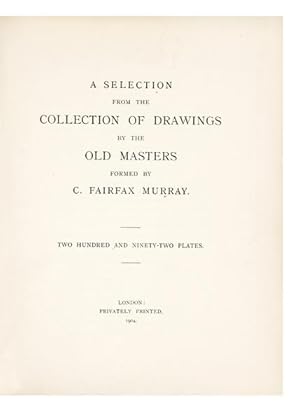



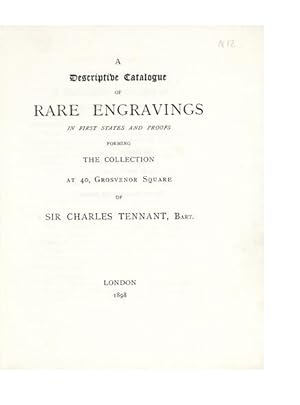

![Imagen del vendedor de Catalogue des Tableaux précieux des Ecoles d'Italie, de Hollande, de Flandres et de France; Dessins, Bronzes, Porcelaines, Pendules, Candelabres, et autres objets de grande Curiosité, composant le Fonds de Commerce du.dont la Vente se fera.le 4 Ventôse, An 6, (Jeudi 22 Févier [sic] 1798).[Expert: A.J. Paillet] a la venta por Jonathan A. Hill, Bookseller Inc.](https://pictures.abebooks.com/inventory/md/md30551600292.jpg)
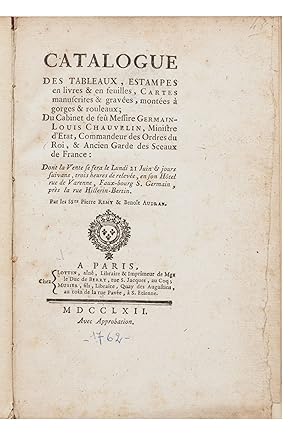
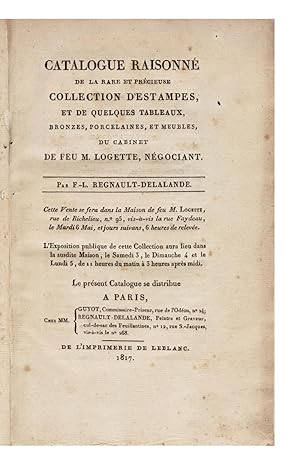
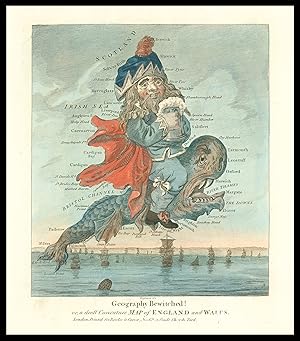
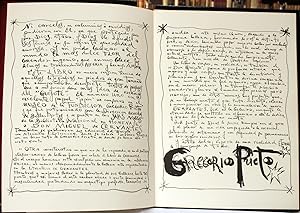
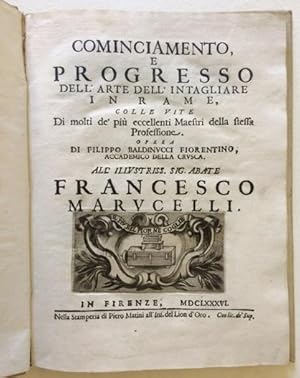
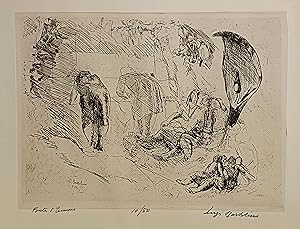
![Imagen del vendedor de Komste van Zyne Majesteit Willem III. Koning van Groot Britanje, enz. in Holland; ofte omstandelyke beschryving van alles, het welke op des zelfs komste en geduurende zyn verblyf, in 's Graavenhaage en elders, ten teeken van vreugde en eere, is opgerecht en voorgevallen [.]. a la venta por Antiquariat INLIBRIS Gilhofer Nfg. GmbH](https://pictures.abebooks.com/inventory/md/md30930315917.jpg)
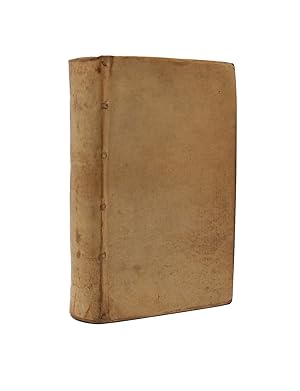
![Imagen del vendedor de Dutch history Leiden 1641 | Beschrijvinge der Stadt Leyden: inhoudende 't begin, den voortgang, ende den wasdom der selver: de stichtinge vande kercken, cloosteren, gasthuysen, ende andere publijcque gestichten ., , tweeden druck, Andries Jansz Cloeting tot Delf, Abraham Commelijn tot Leyden, 1641, (32)+738+[13] pp. [Three volumes in one binding, complete with three folding maps] a la venta por Antiquariaat Arine van der Steur / ILAB](https://pictures.abebooks.com/inventory/md/md31776104525.jpg)

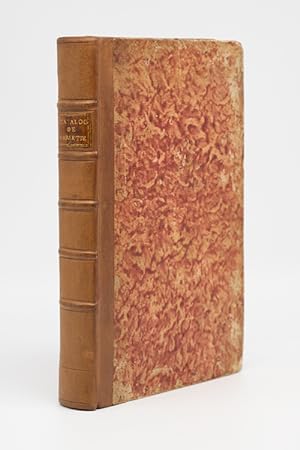


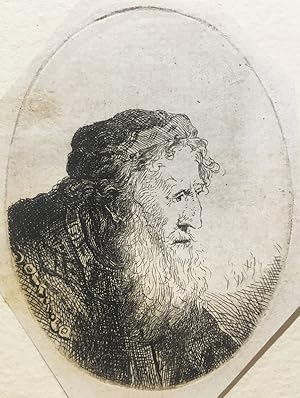
![Imagen del vendedor de [AN ALBUM CONTAINING 38 COPPER PLATES, 32 FROM THE SERIES "BEGGARS" AND THE OTHERS OF RICHLY DRESSED KNIGHTS] DIE BETTLER a la venta por Buddenbrooks, Inc.](https://pictures.abebooks.com/inventory/md/md31412317321.jpg)
